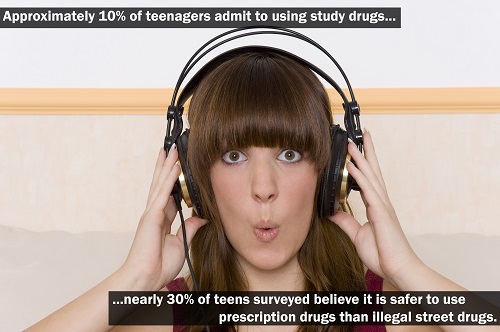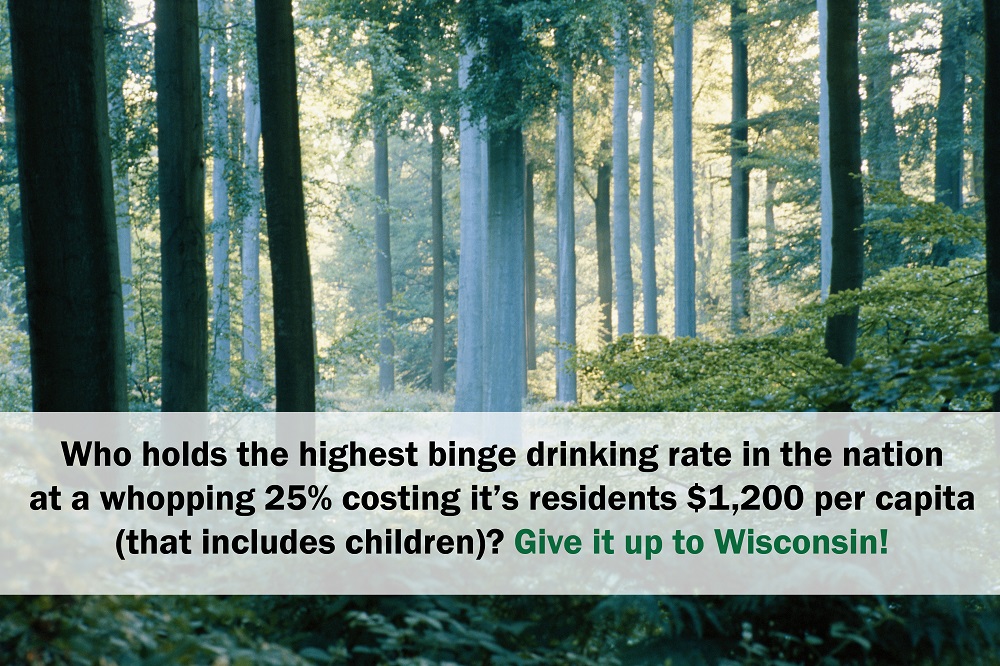25 Jun 2013
Teens and ‘Study Drug’ Abuse
Teenagers have been pulling all-nighters and cramming for tests for as long as schools have existed. Maybe even you have pulled an all-nighter, fueled by nothing more than a 2-liter bottle of caffeinated soda and the fear of telling your parents you failed an important test. Today, however, many teens are turning to something a lot more powerful than Pepsi or Red Bull to help them stay awake while they study. They’re using other substances — the kind that can lead to a serious drug addiction — to fuel their academic endeavors.
Study Drugs
The stimulants typically used as “study drugs” are medications — the kind frequently prescribed for mental health conditions such as attention-deficit hyperactivity disorder (ADHD) and narcolepsy. In teenagers with a legitimate medical need like ADHD, these drugs have a counterbalancing effect on the brain. In essence, they help create a calmer state of mind that allows the teen to focus more readily. When used properly by those who need them, prescription stimulants are not addictive.
These same medicines, however, have a different effect on teens who don’t struggle with ADHD. They start using these medications — for example Ritalin, Concerta, Metadate, or Adderall — with the belief that they will sharpen their focus, boost their energy, help them stay alert, and / or enhance their school performance. While the drugs may provide bursts of energy and improve alertness temporarily, they also quickly create a vicious cycle — the cycle that can easily lead to drug addiction. With continued use, teens often find they need increasing amounts of the drugs to get the same effect, so they keep upping the dose. Eventually they become so dependent on the drug that they can’t function without it.
The drugs, which have street names like Vitamin R, college crack, or Addy, can be taken in their original pill or capsule form. Some teens will crush the pill or open the capsule to snort the drug directly into their system. Regardless of how they are taken, there is no evidence that study drugs boost academic performance in teens not diagnosed with ADHD.
A survey found that approximately 10% of teenagers admit to using study drugs. However, the same survey also revealed that only one in 100 parents believe their teen is using the drugs. The study also found that use was concentrated among white students, while African-American and Latino teens tended to use them less. The use of study drugs rises to as much as 35% in college students. In addition, nearly 30% of teens surveyed believe it is safer to use prescription drugs than illegal street drugs.
Access to Study Drugs
Teenagers can be very savvy when it comes to acquiring these drugs, particularly if they’ve become addicted to them or already struggle with a drug addiction. For example, some will game the health care system by learning the symptoms of ADHD. They convince their parents and doctor that they have the disorder, receiving a legal prescription that then allows them access to one of these study drugs. This method may also permit some adolescents to receive the medication under a parent’s health care plan. This allows them to get the drug without coming up with the money to purchase it themselves.
Another way teens access study drugs is by theft. Some will take advantage of a family member with ADHD, stealing from his or her supply of legitimately prescribed medications. Some teens will steal physicians’ prescription pads to write out their own authorization for the drugs.
Some teens will illegally purchase stimulant medications. For example, they may buy a few pills from a friend who has a legitimate prescription. In fact, research shows that one out of every three teens believes it’s OK to take medications that have not been prescribed to them.
 Why Teens Abuse Study Drugs
Why Teens Abuse Study Drugs
Teenagers face increasing pressure to succeed in school. Kids can be worried that if they don’t get good grades, they won’t be accepted into competitive colleges, won’t win needed grant or scholarship funds, or will become ineligible for high school or college sports. When health science researchers analyzed Twitter feeds for 6 months, they found that Adderall mentions spiked during typical finals periods. Mentions of the study drug were also higher mid-week and lower on the weekend. The findings suggest that students are talking about Adderall during the usual periods of academic stress.
Danger of Study Drug Addiction
Like any prescription medication, ADHD drugs have side effects — some of which are quite common with medications in general. Teens who take these drugs may experience stomach upset, sleep problems, decreased appetite, or daytime drowsiness. Long-term use can also slow height gain, with at least one expert reporting that a user might be as much as a quarter-inch shorter each year.
Study drug abuse has other side effects as well. For example, some individuals taking ADHD medications have reported heart problems. This can be an especially serious issue if an abuser lives with an undiagnosed heart condition. A teen might also develop tics, or repetitive motions, such as head jerking or excessive blinking.
Stimulants may also alter mood. This often occurs as the effects of the drug wear off. Sometimes referred to as the “rebound effect,” some teens may become very sensitive or more irritable. Others may appear to react differently than is normal for them. For example, they may appear to be sad even though they don’t feel sad. These types of side effects are more common in short-acting stimulants.
The abuse of study drugs can also mask the effects of alcohol. A teen using study drugs and drinking may not realize how intoxicated he’s become. He may binge drink because he doesn’t feel the effects of the alcohol. The combination of alcohol and stimulant medication can lead to dangerous situations that result in blackouts, alcohol poisoning, drunken driving and serious accidents and injuries. Approximately two out of three emergency room visits involving ADHD medications also involved at least one other substance, such as alcohol.
Warning Signs of Study Drug Abuse
- Altered mood or behavior, including irritability or intense mood swings
- Periods of sleeplessness
- Decreased appetite or weight loss
- Lapses in memory
- Dilated pupils
- Dry nose and mouth
- Secretive behavior, such as isolation or unexplained spending
What Parents Can Do
If you suspect your teen is abusing study drugs, seek professional help. An addiction specialist can help you come up with a plan to get your teen into rehab. Treatment will include a mental health assessment to identify other challenges your teen may be facing. For instance, he or she may have a co-occurring mental health condition, such as depression or anxiety, that is contributing to the addictive behavior.
Because study drug abuse is often triggered by a desire to perform well, therapy can teach your teen how to deal with stress and anxiety in a healthy manner. A therapist may introduce helpful relaxation techniques, such as breathing exercises or progressive muscle relaxation. Other recommended stress relief remedies may include physical activity, like regular exercise, or a creative outlet, such as journaling.
If your teen does not have ADHD and is abusing Adderall or other stimulant medications, it can lead to drug addiction. Talk with an addiction expert who’s experienced with treating adolescents. Your teenager’s life and well-being are worth more than his or her ability to excel in school.
Read More about Student Drug Abuse: College Student’s Death Sparks Renewed Warnings About the Dangers of Inhalants
The college years are filled with opportunities to compete. From academic contests to dorm room antics, there is a drive on campus to define hierarchies and social order. Even in college partying, where the scene may seem to be much more chaos and order, there are social ordering activities taking place. Drinking games are often used to show how a person handles alcohol or can retain their cognitive abilities while under the influence.
Previous studies have shown that engaging in drinking games can predict whether a college student will drink heavily. However, little is known about whether the type of drinking game will affect how heavily a student will drink. Recently a team of researchers examined various drinking games and their relationship to the drinking behaviors of college students (LaBrie, Ehret & Hummer, 2013).
The participants were recruited through two universities located on the west coast. They were invited to participate in a web-based screening. The researchers used the results to include only the participants who reported consuming at least one drink per week, resulting in 3,421 participants or 68.3 percent of the respondents to the survey.
The participants were asked about demographics, including whether or not they participated in the Greek system and also were asked about their drinking game activities. The researchers asked the participants how many days they participated in drinking games, the games played and the alcohol consumed on the occasions when the games were played.
Alcohol Games leading to Alcohol Abuse and Addiction
 To get an understanding of the various games the students mentioned, the researchers used the Internet to search descriptions of the games. There were 100 distinct games coded by the researchers, distributed into five categories.
To get an understanding of the various games the students mentioned, the researchers used the Internet to search descriptions of the games. There were 100 distinct games coded by the researchers, distributed into five categories.
The results showed that competition games were the most popular games, followed by chance games. The majority of respondents indicated that the competition games were also the games in which they drank the most alcohol.
Peak drinking games were reported differently by gender, race and Greek status. Students who were Caucasian males who participated in the Greek system were most likely to report peak drinking connected with competition games. The highest number of drinks associated with a peak drinking game was found to occur during extreme consumption games.
The authors note several limitations associated with the findings. For instance, the results were based on self-report and suffer the usual possible problems associated with recall bias. In addition, the question related to drinking games was open-ended and may have affected how the students responded.
The findings of the study provide new insight into the influence that the atmosphere and culture of a college campus and its traditions relating to drinking games may impact students’ drinking behaviors. It may serve to educate students about the risks of engaging in tempting competition that leads to heavy drinking.
Alcohol leads to more than addiction, but medical issues too. Read: Alcohol, a Preventable Cancer Risk ‘Hiding in Plain Sight’
According to a recent report, Wisconsin’s binge-drinking problem is costing the state somewhere around $7 billion a year. Surveys show that Wisconsin residents binge drink at a rate of around 25 percent, which is the highest in the nation.
The survey considers having five or more drinks in a sitting as a binge. But the average Wisconsin resident ups the ante and binge drinks on an average of nine beverages per sitting.
 A good chunk of the cost to the state, which is $6.8 billion total, comes in the form of lost worker productivity, which accounts for more than one-third of that total. Vehicle accidents, health care costs and court costs make up around another third of the total.
A good chunk of the cost to the state, which is $6.8 billion total, comes in the form of lost worker productivity, which accounts for more than one-third of that total. Vehicle accidents, health care costs and court costs make up around another third of the total.
Despite the prevalence of this drinking, the state only generated less than $70 million in taxes on booze, which barely makes up for one percent of the burden that booze puts on the state. Given the popularity of alcohol in the state, voters aren’t going to raise taxes on the product, either. The tax hasn’t changed since the late 1960s.
To break it down into what alcohol abuse is costing each individual resident, experts have put the tab at $1,200 per capita. That includes children. In 2011, it is reported that more than 1,500 residents died in alcohol-related incidents. About 48,000 were hospitalized and another 60,000 were arrested under the influence.
17 Jun 2013
Molly – An Unsuspecting Name for a Potent Drug
Taking the good with the bad is a life lesson that everyone learns at some point. But young people involved in the rave culture are finding that drugs bringing on extremely intense feelings of pleasure have an equally displeasing depressing effect.
The drug, Molly, has a name that sounds innocent enough, but unsuspecting users are devastated by the crash they experience when coming off the high. In some cases, the depressing feelings lead to a near paralyzing state where the user can’t find the mental strength to eat or communicate.
The intense emotional ride and the relatively cheap cost of that ride are helping push the popularity of Molly further every day. The drug is actually the powder or crystal form of MDMA (AKA Ecstasy). The popular drug Ecstasy is actually derived from a variety of drugs, not just MDMA. Molly is a purer form of Ecstasy and actually gets its name from “molecule,” which is representative of its place as the vital ingredient to MDMA.
The DEA has classified Molly as a Schedule I controlled substance due to its addictive nature and because it has not been embraced by the medical community as having any usable characteristics in health care.
Users who take too much of the drug will have a difficult time with temperature regulation and can actually experience hyperthermia, which can lead to liver, cardiovascular and kidney failure.
The current statistics from emergency rooms across the nation don’t indicate that the use of this drug is widespread yet. But the massive growth in its popularity in such a short time has experts concerned – there was an approximate 125 percent growth in the use of the drug between 2004 and 2009.
Continue reading: Understanding the Effects of Substituted Amphetamines
Addiction can be challenging to treat, and some addictions are particularly so. For example, many individuals who enter a substance abuse treatment center for cocaine addiction and complete the treatment program soon return due to relapse. The tools acquired in treatment for dealing with cravings are sometimes not effective in patients who have a particularly challenging case of addiction to cocaine.
 A new study indicates that there may be help for those who have a cocaine addiction that does not respond to traditional treatments. While there has been little success in treating cocaine addiction with medications, the study finds that this strategy may be effective in certain situations.
A new study indicates that there may be help for those who have a cocaine addiction that does not respond to traditional treatments. While there has been little success in treating cocaine addiction with medications, the study finds that this strategy may be effective in certain situations.
Disulfiram is a medication that has been approved for treatment in alcohol addiction for 50 years. Its effectiveness is rooted in the blocking of acetaldehyde metabolism, causing acetaldehyde to build up in the body. The result is an unpleasant mix of nausea, headache and vomiting, accompanied by an increased heart rate. Those who take Disulfiram may quickly learn to avoid drinking alcohol.
Based on previous studies at Yale University that linked a Disulfiram-related reduction in the use of cocaine when paired with alcohol or opiate dependence, researchers recently published new findings in the journal Biological Psychiatry that support the use of Disulfiram in treating cocaine addiction.
The study’s findings show that Disulfiram is able to inhibit dopamine ß-hydroxylase, or DßH, which is an enzyme responsible for the conversion of dopamine to norepinephrine.
Led by Thomas Kosten, the researchers examined Disulfiram’s effectiveness among cocaine and opioid dependent participants who received either the medication or a placebo over a ten-week period.
The researchers also genotyped the DßH gene, which controls the levels of the enzyme to determine which variant of the gene was present in each patient. The researchers wanted to determine whether the variant impacted the success of the Disulfiram as a treatment for cocaine addiction.
The study results showed that Disulfiram was effective in reducing the use of cocaine among the participants according to the DßH gene variant they possessed. The data supported the researchers’ expectation that Disulfiram impacted cocaine consumption by blocking DßH.
The researchers note that there was a significantly greater effectiveness related to Disulfiram use among those participants that carried the genetic variant, and this accounts for perhaps about 60 percent of cocaine addicts. This supports the use of pharmacogenetic matching to establish the best strategy for treatment of cocaine addiction.
The findings are particularly promising, given the challenge that has been connected with treatment for cocaine addiction. While the medication may not effectively treat every individual with cocaine addiction, it may help close the gap for those who carry the necessary genetic variant.
Drug addiction is developed through a combination of biological and environmental factors. Each patient with an addiction represents a unique combination of factors that led to the condition. However, even if two individuals have identical environments, it does not guarantee that both individuals will have identical outcomes with addiction development.
A new study helps to explain why some individuals are able to use drugs, but do not develop an addiction. It also helps to explain why some patients are able to resist cravings after completing a substance abuse treatment program, while others experience relapse.
The study, conducted by researchers at the RIKEN Center for Molecular Imaging Science, located in Japan, and the Montreal Neurological Institute at McGill University in Canada, provides new information about brain circuitry that controls decision-making. The study finds that addiction may be linked to abnormal functions in the frontal cortex, the area that is responsible for decision-making.

The study’s findings are published in a recent issue of the journal Proceedings of the National Academy of Sciences of the USA. They show that the orbital and lateral regions of the brain, located in the frontal cortex, work together when cue related to drugs or craving is introduced. When those two areas of the brain do not work together well, addiction may be the result.
To examine this function of the brain, the researchers used a combination of tools, uniting functional magnetic resonance imaging (fMRI) with transcranial magnetic stimulation (TMS). The participants included 10 smokers, who were evaluated for cue-induced cravings and the resulting neural mechanisms. The researchers based this examination not only on cravings, but how the brain responds when drugs are not available, despite a craving.
The researchers found that among smokers the orbitofrontal cortex (OFC) was key in monitoring the level of craving and the dorsolateral prefrontal cortex (DPFC) evaluated drug cues and availability of the drug. The study demonstrated that the DPFC was able to suppress functions in the OFC if the cigarette was not available to the individual.
The study also tested the results of the DPFC being non-active using TMS and found that cravings and the related signals occurring in the OFC were not related to drug availability.
With these findings, the researchers conclude that the DPFC is central to functions of drug cues and evaluating drug availability and then works with the OFC where the information from the DPFC is used to determine whether drug-seeking behaviors will follow.
The authors of the study explain that in their smoker participants, after evaluating the drug cues and availability status in the DFPC, the cravings accumulated in the OFC. The authors found the results interesting, given that the neural circuits involved are central to decision-making and self-control, but normally guide an individual to making the most beneficial decision.
There are many research studies out there trying to understand drug addiction. Read Drug Addiction ‘Turned Off’ With Lasers to see another take on addiction recovery.
 The war on drugs has cost tax payers billions of dollars. In 2010 alone, the misuse of drugs cost America nearly 40,000 lives. Alcohol was blamed as a factor in about 85,000 deaths. Prescription drug abuse led to more than 22,000 deaths in 2010.
The war on drugs has cost tax payers billions of dollars. In 2010 alone, the misuse of drugs cost America nearly 40,000 lives. Alcohol was blamed as a factor in about 85,000 deaths. Prescription drug abuse led to more than 22,000 deaths in 2010.
New statistics coming out of the state of New Mexico are causing worry among health officials there. The state has some of the most alarming statistics when it comes to alcohol abuse. New Mexico holds the inauspicious record for the highest number of alcohol-related deaths in the nation since 1997. Drug abuse in the state also lands it squarely in the top three states year after year.
What’s leading to the massive rate of use and abuse in New Mexico? The New Mexico Youth Risk and Resiliency Survey of middle school and high school students found that many youths can easily obtain illegal substances with few, if any, significant obstacles in their way. Two-thirds of that survey’s recipients said that alcohol is readily accessible.
The survey found that 66 percent of teens judged access to marijuana as “uncomplicated.” In addition, 28 percent of high-schoolers said that “hard drugs” were readily accessible.
The state is getting “SWAT” teams in on the action by establishing relationships with the state’s youth. But these are not the SWAT teams dressed in black, carrying assault weapons. SWAT stands for Student Wellness Action Team. The members work with public and private schools to provide alcohol and drug awareness to youths across the state.
North and South America have half of the world’s heroin abusers, 45 percent of cocaine users and a quarter of marijuana users, according to a report from the Organization of American States (OAS). The current approach, the “war on drugs,” is severely lacking in support in the modern day, with numerous experts suggesting a more liberal strategy that re-phrases drug use as a health issue rather than a criminal one. This idea has been yet again proposed in a 200-page report from the OAS, urging American leaders to rethink their policies in the interest of users across the continents. Their argument takes several stands, looking at addiction as a health problem, considering the severe harm done by the drug trade, and the financial impact on both law enforcement and organized crime groups.
The Drug Use Report
 The purpose of the report was to prevent a starkly realistic portrayal of the impact of drugs across the Americas. José Insulza, secretary general of the OAS, said it is intended “to show the volume of money that changes hands and who benefits from it; to show how it erodes our social organization and how it undermines the health of our people, the quality of our governments and even our democracy.”
The purpose of the report was to prevent a starkly realistic portrayal of the impact of drugs across the Americas. José Insulza, secretary general of the OAS, said it is intended “to show the volume of money that changes hands and who benefits from it; to show how it erodes our social organization and how it undermines the health of our people, the quality of our governments and even our democracy.”
In addition to this, the report looks at the policies that have been implemented to date and the consequences if the problem isn’t dealt with more intelligently. The overall conclusion is that increased access to treatment, reduction of criminal punishments for use of drugs and strategies tailored to the conditions in the individual countries are the best approaches.
The Drug Trade
The damage done by the drug trade is one of the key points raised to support the viewpoint. As an example, Latin America produces essentially all of the cocaine consumed by Western users. The trade is run by criminal organizations, which have risen in power and come to undermine the rule of law in the region, breeding corruption, creating violence and destroying human rights. Human rights activists and journalists who expose the violence and politicians who refuse to be corrupted are at significant risk. The biggest damage, however, is to citizens caught in the crossfire between criminal gangs. Overall, the drug trade kills thousands each year across places like Central America, Mexico and Columbia.
Financial Benefits
The current system is financially beneficial only to the criminal gangs who supply and produce the illicit drugs. Nobody would buy alcohol from a gang, because it is available across the Americas and the companies who make it have standards to abide by. The black market in drugs, however, relies on those gangs entirely. According to the secretary general Insulza, this generates around $151 billion in retail for the gangs across the continents. This funds other illicit activity, and the industry also saps money from governments on both continents. In 2010 alone, the US spent $15 billion on the war on drugs, both internationally (significant chunks of the money goes to Columbia, for example) and domestically. The current system, in short, is a financial black hole.
Drug Abuse: It’s a Health Issue
The core message of the document is that addiction is a public health issue, not a criminal one. This has been stated numerous times, but the report emphatically states that decriminalization of drug use should be the basis for all public health strategies. It echoes the commonly stated criticism that addicts shouldn’t be punished for having what is widely recognized as an illness.
Drug addiction reprograms the addicts’ brains to crave drugs, so the choice to continue to use an illicit substance isn’t a moral failing; it’s more like a diabetes-sufferer having hyperglycemia after unknowingly consuming a sugary snack. Drug cravings are a symptom of an illness in exactly the same way hyperglycemia is a symptom of reduced insulin production. Perhaps the diabetes sufferer consumed too much sugary food throughout his life and consequently developed type 2 diabetes, but we don’t morally chastise him for it. Drug users have a mental health issue, which requires treatment as opposed to criminal punishment.
Sounds Good, But Is There Enough Support?
The reduction of penalties for drug abuse is obviously vital to this approach, but the support for the idea is rarely in line with the recommendations. The report isn’t in favor of legalization of all drugs—it advocates legalization of marijuana but suggests a decriminalized approach for other drugs. This would essentially render drug offences legally equivalent to traffic violations, which are rarely jail-worthy. While some of the 35 member states are receptive to the legalization of marijuana, they didn’t find any notable support for the decriminalization of any other currently illegal drug.
Despite this predictable setback, the report adds to a growing body of thought which should be nagging at politicians all over the world. Criminal approaches to tackling drug abuse don’t work; it’s essentially a punishment for suffering from a health condition. While it may be easier to avoid controversy if the idea is quietly brushed aside, you can only metaphorically cover your eyes and pretend you don’t see the evidence for so long.


